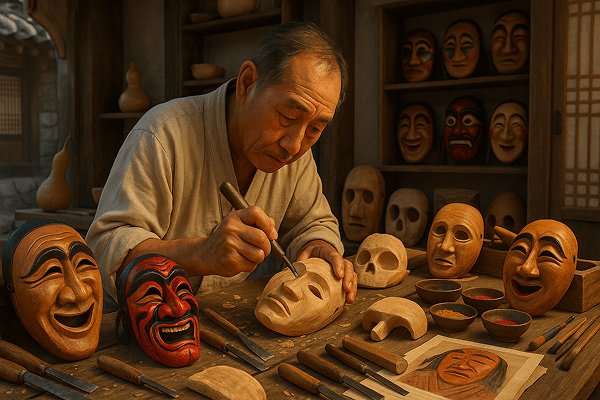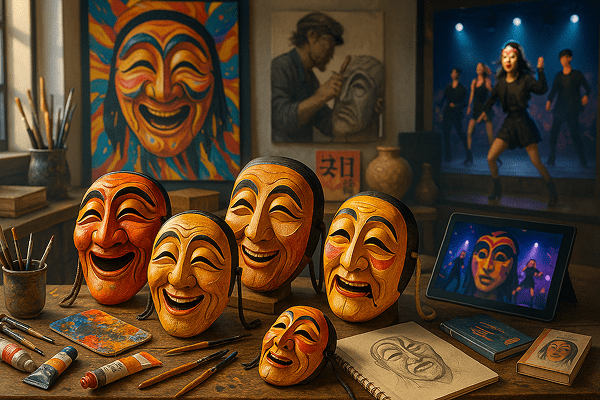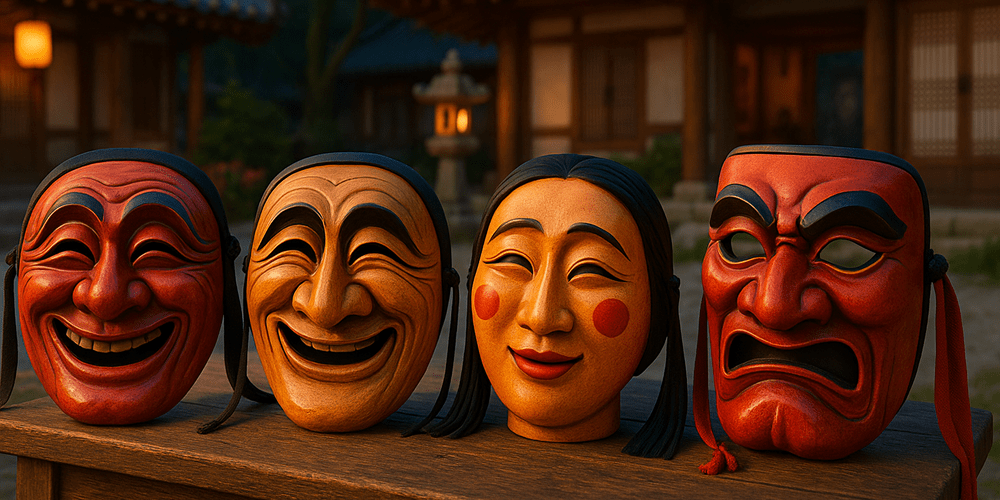Tal Masks, also known simply as “tal” (탈, meaning “mask” in Korean), are among the most vivid and expressive artifacts of Korea’s cultural heritage. These traditional Korean masks are famed for their exaggerated facial features, bold lines, and vibrant colors, which allow them to convey a wide spectrum of emotions — from joy and sorrow to anger and mischief. Typically crafted from lightweight wood, papier-mâché, or gourds, Tal Masks are distinguished by their movable jaws, dramatic eyebrows, and stylized expressions. They originate from various regions of the Korean Peninsula, with some of the most famous variations emerging during the Goryeo and Joseon dynasties (10th–19th centuries). Today, Tal Masks serve as powerful symbols of Korea’s artistic ingenuity and communal spirit.
Historical Origins: The Evolution and Meaning of Tal Masks
The roots of Tal Masks in Korea are ancient, stretching back over a millennium. The word “tal” itself is simply the Korean word for “mask,” but the tradition encompasses a remarkable diversity of styles and functions. The earliest references to Korean masks appear in historical records from the Three Kingdoms period (circa 57 BCE–668 CE), where masks were used in shamanistic rituals and court entertainments. Over time, the craft evolved, especially during the Goryeo dynasty (918–1392 CE), when mask dances became popular forms of folk and court performance.
The design and function of Tal Masks have continually adapted to social and religious changes. By the Joseon period (1392–1910 CE), masks were widely used in village rituals, exorcisms, and the now-famous masked dance dramas known as talchum. The etymology of “tal” is straightforward, but each specific mask often carries its own name — such as Yangban (aristocrat), Bune (young woman), or Choraengi (servant) — reflecting its role in performance or ritual.
Significant archaeological finds, such as ancient wooden and clay masks, as well as painted scrolls and historical texts, testify to the enduring importance of Tal Masks in Korean culture. The Hahoe Masks of Andong, for instance, are among the best-documented and most celebrated examples, often cited in both Korean and international scholarship.
Cultural Significance and Symbolism: Tal Masks as Mirrors of Society and Spirit
Tal Masks are much more than theatrical props — they are deeply embedded with spiritual and social meaning. In Korea, masks are believed to mediate between the human and supernatural realms, protecting communities from evil spirits, disease, and misfortune. Many myths and legends surround their origins, often involving stories of shamans or villagers who crafted masks to appease restless spirits or bring about good fortune.
Ritually, Tal Masks have been used in exorcisms (gut), harvest festivals, and funerary rites. Spiritually, they represent the ability to transcend ordinary identity, allowing the wearer to embody ancestors, deities, or social archetypes. The expressive faces of the mask s— sometimes grotesque, sometimes comical — reflect the Korean worldview that life is a mix of hardship and joy, tragedy and humor.
Socially, Tal Masks serve as powerful tools for satire and social commentary. Through masked performances, villagers could lampoon the elite, challenge authority, and explore taboo subjects. This function persists today, with talchum performances still offering sharp, playful critiques of society. The Hahoe Masks, in particular, are renowned for their ability to convey deep psychological nuance and social symbolism.
Materials and Craftsmanship: The Art of Creating Tal Masks
The traditional creation of Tal Masks is an intricate and respected craft, often passed down through generations of artisans. Historically, the most common materials have been paulownia wood, pine, and alder, prized for their lightweight and workable qualities. In some regions, masks are made from papier-mâché, gourds, or even leather.

The mask-making process involves several stages:
- Selecting and curing the wood or preparing papier-mâché
- Rough carving the basic form with adzes and chisels
- Detailing facial features with knives and specialized tools
- Smoothing, hollowing, and painting with natural pigments (such as ochre, charcoal, and cinnabar)
- Adding features like movable jaws (a hallmark of Hahoe Masks) and attaching cords or fabric
Regional variations exist, with the most famous styles coming from Hahoe (Andong), Yangju, Bongsan, and Tongyeong. Each region’s masks display unique decorative elements and color symbolism — for example, red may signify vitality or anger, while white denotes purity or old age.
Functions and Uses: Ritual, Theatre, and Celebration
Tal Masks have served a wide array of functions throughout Korean history. Traditionally, they were integral to shamanistic rituals, where they protected communities and facilitated communication with spirits. In village festivals, masked dances marked the changing of the seasons, agricultural cycles, and important communal events.
Theatrically, Tal Masks are essential to talchum, the mask dance drama that combines dance, music, satire, and storytelling. These performances, still popular today, use masks to embody stock characters and portray stories of love, conflict, and social satire. Masks also appear in Buddhist temple ceremonies and Confucian rites, though their primary association is with folk and shamanistic contexts.
Over time, the use of Tal Masks has broadened to include modern festivals, parades, and cultural exhibitions. They are also popular as decorative items and souvenirs, representing Korean identity both at home and abroad.
Regional Variations: Diversity in Tal Mask Traditions
Korea’s diverse geography and history have given rise to numerous regional mask traditions. The Hahoe Masks of Andong are perhaps the most famous, known for their sophisticated expressions and movable jaws. Yangju Tal Masks are distinctive for their exaggerated features and bright colors, while Bongsan and Tongyeong masks are celebrated for their stylized forms and unique character types.
Each regional tradition is tied to a specific style of performance and local history. For example, the Hahoe Mask Dance Drama is performed annually in Andong and is listed by UNESCO as Intangible Cultural Heritage. Comparisons with Japanese Noh masks or Chinese Nuo masks reveal both similarities and profound cultural differences, underscoring the unique role of Tal Masks within the broader world of Asian theatrical masks.
Notable Examples and Collections: Where to See Tal Masks
Some of the finest examples of Tal Masks are preserved in Korean museums and international collections. The National Museum of Korea, Andong Mask Museum, and Hahoe Folk Village display historic masks alongside contemporary works. Notable artifacts include centuries-old Hahoe Masks, festival masks from Yangju and Bongsan, and rare ceremonial masks from Buddhist and shamanistic contexts.
Internationally, institutions such as the British Museum and the Smithsonian hold important Korean masks, reflecting their global significance. Private collections and online galleries — such as toddmasks.com — play a key role in preserving and sharing the artistry of Tal Masks with a worldwide audience.
Influence on Art and Culture: Tal Masks in Modern Creativity
The influence of Tal Masks on Korean art and culture is both deep and wide-ranging. Their bold designs have inspired generations of painters, sculptors, and contemporary performance artists. The masks appear in literature, cinema, and even K-pop music videos, symbolizing both tradition and transformation.

In the world of design and fashion, Tal Mask motifs are used in textiles, jewelry, and product design, reflecting the enduring allure of Korean folk art. The preservation and reinterpretation of Tal Masks help maintain a living connection to the past, while also fueling new artistic innovation. The Hahoe Masks, in particular, have become icons of Korean identity and are frequently featured in global exhibitions and collaborations.
Contemporary Status and Tradition Preservation: Safeguarding the Legacy of Tal Masks
Today, the tradition of Tal Mask-making and performance is actively preserved by master artisans, cultural organizations, and communities. Schools and workshops in regions like Andong, Yangju, and Bongsan teach traditional carving and performance techniques, ensuring that knowledge is passed on to future generations.
Preservation efforts include government recognition of mask-making as an Important Intangible Cultural Asset, documentation projects, and international partnerships. Contemporary artists continue to reinterpret the tradition, experimenting with new materials and themes while honoring the masks’ spiritual and social roots.
Educational programs, festivals, and master classes provide hands-on opportunities for students and enthusiasts to engage with Tal Mask culture. Platforms like toddmasks.com further promote appreciation and awareness, supporting both traditional artists and modern creators.
Collecting and Acquisition: The Market for Tal Masks
The market for Tal Masks encompasses everything from affordable souvenirs to museum-quality masterpieces. Authentic masks — especially antique or ceremonial pieces — are highly prized by collectors and institutions. Prices are determined by factors such as age, provenance, craftsmanship, artistic quality, and regional origin.
Genuine Tal Masks can be acquired from reputable dealers, museum shops, and directly from artisans. Collectors are advised to seek documentation and expert evaluation, paying close attention to materials, construction, and regional characteristics. Ethical collecting is paramount: supporting living artists and respecting cultural heritage laws help ensure the sustainable future of Tal Mask traditions.
